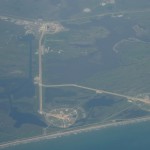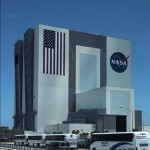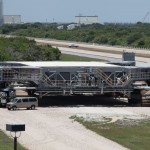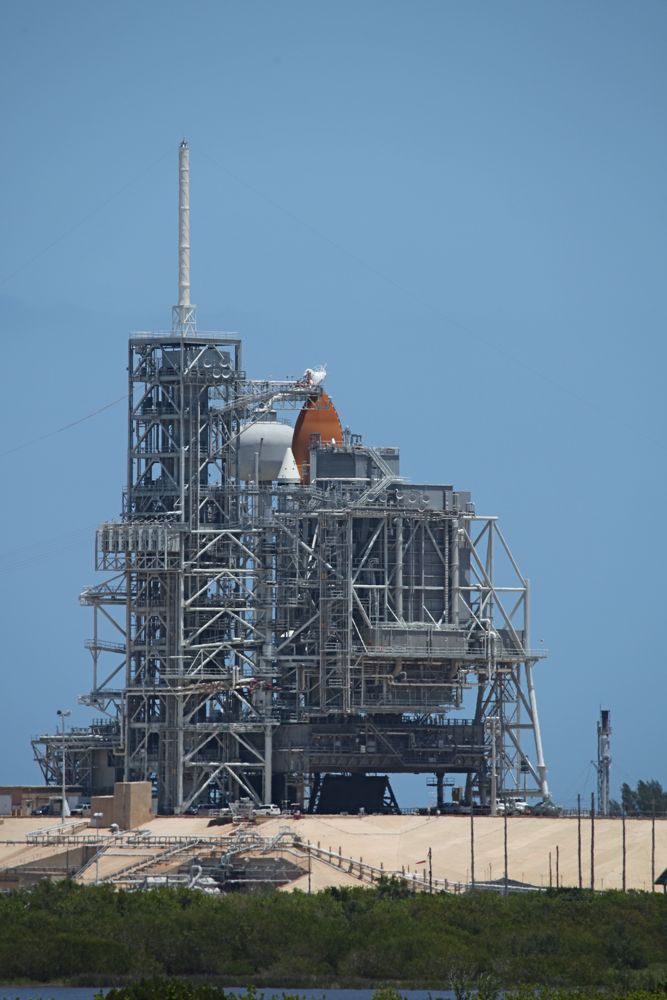Kennedy Space Center, day 1, part 1
After sampling a variety of lounges, my flying continued with the last leg from Chicago to Fort Lauderdale, Florida. I didn’t plan to take this routing for any reason except that the times were convenient. However, as we approached our destination, I was woken by the captain announcing that the Kennedy Space Center was visible to the right. Since the reason for my trip was to see the launch of the Space Shuttle, getting a preview from 37,000 feet was a real bonus. The photo at the right shows Launch Complex 39, with the Vehicle Assembly Building at the top, launch pad 39A (with the shuttle already on it) at the bottom, and pad 39B off to the right.
I’d flown into Fort Lauderdale because of the cheap first class airfare available LAX-FLL; I’ve written previously about how to find such fares. It did however mean that the rest of that day was taken up with driving from Fort Lauderdale to Orlando, which was where the closest available hotel was at the time I booked. I’d planned to allow a spare day before the shuttle launch (on 14 May), in case of flight delays. But despite the flight delays I’d encountered, I ended up in Fort Lauderdale on time, and so had a full day spare to visit the Kennedy Space Center (KSC).
The Orlando region is famous for its many theme parks, but the KSC beats them all for value, and in most other ways (except for a distinct lack of people wearing mouse ears). For half the price of a day’s admission to one of the Walt Disney World parks, you get two days access to the KSC. I’d use one day before the launch, and the other afterwards (assuming the shuttle launched on schedule).
After quickly surveying all the options, the first activity I did was to take the bus tour that’s included with the price of admission. (There are other bus tours available as well, but they cost extra, and were booked out for all the days I’d be there.) The first stop on the tour was the massive Vehicle Assembly Building (VAB). It’s 160 metres high, but I find that it’s difficult to gauge that kind of scale, particularly when you’re not sure how far away you are. Perhaps a better yardstick is the stars in the US flag, which are each as tall as me (6 feet or 1.83 m). In any case, it’s huge; it was used to assemble the Saturn V stack for the Apollo program, was then modified to handle the shorter but wider space shuttle stack.
From the VAB, the bus then followed the path of the crawler tracks towards pad 39A. Our destination was the Observation Gantry, which is about 3 miles from pad 39A. Right next to the gantry was one of the crawlers, presumably the one that deposited the shuttle on the pad about a month previously.
But of course the main item of interest was the shuttle itself, sitting almost ready to launch on pad 39A. A kind gentleman from Germany allowed me to borrow his 100-400mm lens, with which I took the photo below. The orange bit is the top of the external fuel tank; the white object attached to its side is one of the solid rocket boosters, while the roundish tank in the background is the water tower (actually some distance away) for the sound suppression system. The shuttle orbiter itself is not really visible at all: it’s covered on the near side by the gantry used for loading the payload while maintaining a sterile environment. On top of the launch tower to the left is a lightning rod (I presume).
Stay tuned for the second part of this entry soon.



